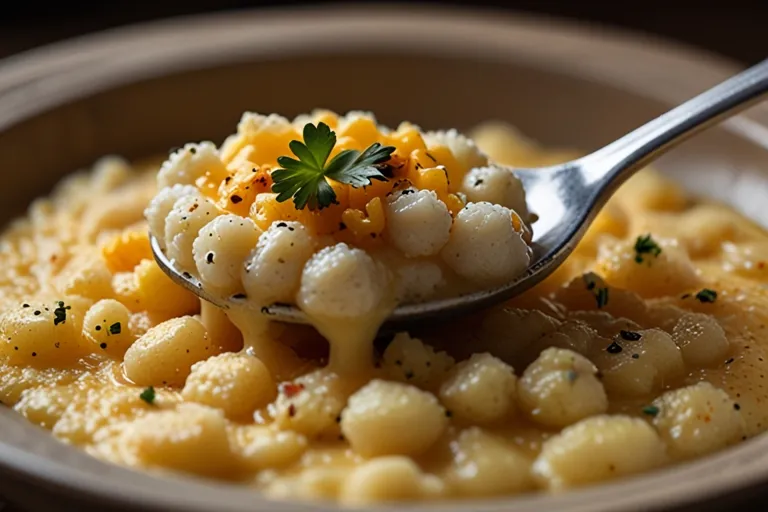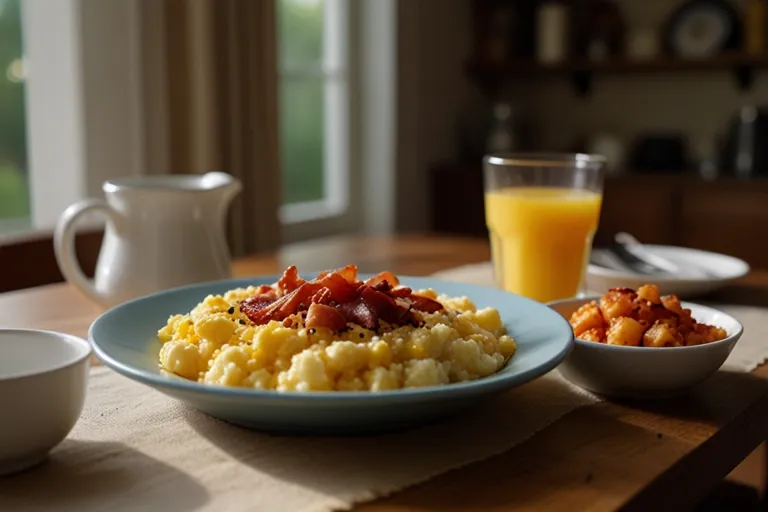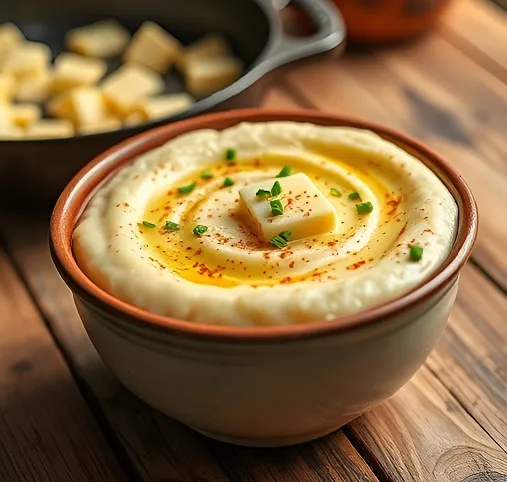Alright, so you wanna make some seriously good grits, huh? Well, you’ve come to the right place! This guide is gonna walk you through everything you need to know to whip up the perfect bowl of hominy grits. We’re talking about creamy, dreamy deliciousness, whether you’re having breakfast, lunch, or dinner. We’ll cover the basics, some tasty twists, and even answer all those burning questions you might have. Ready to get started? Let’s do this!
Table of Contents
Introduction: Why You Need This Recipe

What are Hominy Grits?
Okay, let’s get down to the nitty-gritty (pun intended!). Basically, hominy grits are ground corn. But not just any corn! It’s corn that’s been through a special process called nixtamalization. This fancy word just means the corn kernels are soaked in an alkaline solution, like lime water. This makes them softer and changes their flavor and nutritional value. Think of it like magic for corn! The result? A versatile ingredient that can be cooked up into a smooth, comforting porridge.
A Brief History and Cultural Significance of Grits
Grits have a long and rich history, especially in the Southern United States. They were a staple food for Native Americans long before European settlers arrived. Over time, grits became a cornerstone of Southern cuisine, showing up on breakfast tables, in fancy restaurants, and everywhere in between. Honestly, for many folks, grits aren’t just food; they’re a taste of home and tradition.
Why This Hominy Recipe is Your Go-To Guide
Look, there are tons of hominy grits recipes out there. But this one? This one’s different. We’re going to break it down, keep it simple, and give you all the tips and tricks to make amazing grits every single time. No more lumpy, bland grits – promise! We’ll even look at ways to make cheesy grits and other delicious variations.
Understanding the Key Ingredient
Types of Hominy Grits: Stone-Ground, Quick
Now, before we dive into the hominy grits recipe itself, it’s important to understand the different kinds of grits you’ll find. First up, you’ve got stone-ground grits. These are the least processed, retaining more of the corn’s natural flavor and texture. Consequently, they take the longest to cook and have a slightly coarser feel. Next, there are quick grits. As the name suggests, these are milled finer, which means they cook much faster. Finally, you have instant grits. Honestly, while they’re convenient, they often lack the flavor and texture of the other types. Think of it like the difference between freshly brewed coffee and instant coffee—you get the idea.
The Importance of Choosing the Right Grits for Your Recipe
So, which type should you pick? Well, it really depends on your preference and how much time you have. For the best flavor and texture in our hominy grits recipe, stone-ground grits are generally preferred. However, quick grits are a good compromise if you’re short on time but still want a decent result. Personally, I usually go for stone-ground when I’m not in a rush.
Understanding the Texture and Flavor Profiles of Different Grits
As we touched on before, stone-ground grits have a more robust, corny flavor and a slightly nubby texture. Quick grits are smoother and have a milder flavor. Instant grits are the smoothest and can sometimes taste a bit bland. It’s like comparing a hearty stew to, well, something less exciting. Choosing the right type can really make or break your hominy grits recipe. Sometimes, I wonder if folks enjoy a good BBQ chicken flatbread more than bland grits! Food preferences are definitely interesting.
Where to Buy the Best Hominy Grits
You can find grits in most grocery stores. However, for stone-ground grits, you might have better luck at specialty food stores, farmers’ markets, or even online. Look for grits that are labeled “whole grain” for the best flavor and nutrition. Don’t be afraid to try different brands to find your favorite!
The Basic Recipe: A Step-by-Step
Gathering Your Ingredients for the Perfect Grits Recipe
Alright, let’s get to the good stuff! To make a fantastic hominy grits recipe, you won’t need a ton of fancy ingredients. First, you’ll need, of course, your holy grits. Then, you’ll need water or broth – we’ll talk more about that later. You’ll also want some butter for richness and salt and pepper to season. That’s it for the basics! Keep it simple, you know?
Essential Equipment for Cooking Hominy Grits (H3)
Thankfully, you don’t need any special gadgets for this homemade grits recipe. You’ll need a saucepan – a medium-sized one works great. A whisk is helpful for stirring and preventing lumps, though a spoon will do in a pinch. And a measuring cup and spoons are essential for getting the ratios right. That’s honestly all there is to it!
Instructions for Making Classic Hominy Grits
Okay, here’s the lowdown on making classic hominy grits. First, bring your water or broth to a boil in your saucepan. Next, slowly whisk in your grits. This is important to avoid clumps! Then, reduce the heat to low, cover the pot, and let the grits simmer. You’ll need to stir them occasionally—think every 5-10 minutes – to keep them smooth. The cooking time will vary depending on the type of grits you’re using, so follow the package directions. Finally, once the grits are creamy and thickened, stir in the butter, salt, and pepper. Taste and adjust the seasoning as needed.
Tips for Avoiding to Achieve Creamy Texture
Nobody likes lumpy gritty, right? So, here are a few tips to avoid them. First, whisk the grits in slowly while the liquid is boiling. Second, keep the heat low and stir frequently. Third, don’t be afraid to add a little extra liquid if the grains become too thick. For extra creaminess, some folks like to use milk or half-and-half instead of water. Honestly, experimenting is part of the fun! And just like a perfectly cooked grits recipe can make your day, so can discovering a new favorite food, like maybe a really good BBQ chicken flatbread! Okay, maybe not instead of grits, but you get the idea.
Serving Suggestions and Pairing Ideas for Your Hominy Grits
Hominy Grits for Breakfast: Classic Pairings

First of all, let’s face it, hominy grits are a breakfast superstar! In fact, the classic pairing is with eggs – scrambled, fried, poached, you name it. Moreover, you can add some crispy bacon, sausage, or ham on the side, and consequently, you’ve got a breakfast of champions. Honestly, a warm bowl of grits with a runny egg is just pure comfort food. For more breakfast inspiration,
Grits Beyond Breakfast: Lunch and Dinner Ideas
Moving on, don’t limit your hominy grits recipe to breakfast! Instead, grits are incredibly versatile for lunch and dinner too. For instance, top them with grilled shrimp, blackened fish, or slow-cooked pulled pork for a hearty meal. Furthermore, they also make a fantastic base for stews and braises. For example, think about serving them alongside some flavorful collard greens or roasted vegetables.
Creative Uses for Leftover Grits
Now, what about leftover grits? Well, don’t toss ’em! Instead, you can spread them in a baking dish, let them cool, cut them into squares, and then fry or bake them for a crispy treat. Alternatively, another idea is to mix them with cheese and breadcrumbs, form them into patties, and pan-fry them. Honestly, leftover grits are like a blank canvas for culinary creativity!
Garnishes and Toppings to Improve Your Grits Dish
Finally, a simple garnish can really brighten up your hominy grits recipe. For example, think fresh chives, a sprinkle of paprika, a drizzle of hot sauce, or a dollop of sour cream. Similarly, for cheesey grits, a sprinkle of extra cheese never hurts! So, get creative and add your favorite flavors.
Pro Tips for Grits Perfection
Boosting Flavor with Broth or Milk
First, if you want to kick your hominy grits recipe up a notch, try cooking your grits in chicken or vegetable broth instead of just water. As a result, this adds a richer, more savory flavor. Similarly, using milk or half-and-half will make your grits extra creamy. Ultimately, it’s a simple swap that makes a big difference!
The Importance of Seasoning Your Grits Properly
Next, don’t skimp on the seasoning! Indeed, salt is crucial for bringing out the flavor of the corn. Therefore, add salt to the cooking liquid and then taste and adjust again at the end. Also, pepper is another must-have. Some folks even like to add a pinch of garlic powder or onion powder, too.
Knowing When Your Grits Are Done
Now, if you’re not serving your grits right away, you can keep them warm in a slow cooker on the “warm” setting. Alternatively, you can place the pot over a very low heat on the stovetop and, if necessary, stir in a little extra liquid if they start to thicken too much.
Making Grits in Advance: Storage and Reheating
Finally, yes, you can make grits ahead of time! To do this, store cooked grits in an airtight container in the refrigerator for up to 3-4 days. Then, to reheat, add a splash of liquid (water or milk) and cook over low heat, stirring until smooth and creamy again. You can also reheat them in the microwave, of course.

